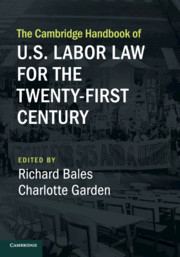Book contents
- Advance Praise for The Cambridge Handbook of U.S. Labor Law for the Twenty-First Century
- The Cambridge Handbook of U.S. Labor Law for the Twenty-First Century
- The Cambridge Handbook of U.S. Labor Law for the Twenty-First Century
- Copyright page
- Contents
- Contributors
- Preface
- Acknowledgments
- Part I Introduction
- Part II Labor Law Is Out of Date
- 3 Yesterday’s Labor Law and Today’s Challenges
- 4 The National Labor Relations Board in the Twenty-First Century
- 5 Beyond the Race to the Bottom
- 6 Union Rights for All
- 7 Public Sector Innovations
- 8 Combatting Union Monopoly Power
- 9 The Case for Repealing the Firm Exemption to Antitrust
- 10 Make Labor Organizing a Civil Right
- Part III The “Fissured” Workplace
- Part IV Barriers to Forming a Collective Bargaining Relationship
- Part V Barriers to Bargaining a Good Contract
- Part VI Unions, Civil Society, and Culture
4 - The National Labor Relations Board in the Twenty-First Century
from Part II - Labor Law Is Out of Date
Published online by Cambridge University Press: 01 November 2019
- Advance Praise for The Cambridge Handbook of U.S. Labor Law for the Twenty-First Century
- The Cambridge Handbook of U.S. Labor Law for the Twenty-First Century
- The Cambridge Handbook of U.S. Labor Law for the Twenty-First Century
- Copyright page
- Contents
- Contributors
- Preface
- Acknowledgments
- Part I Introduction
- Part II Labor Law Is Out of Date
- 3 Yesterday’s Labor Law and Today’s Challenges
- 4 The National Labor Relations Board in the Twenty-First Century
- 5 Beyond the Race to the Bottom
- 6 Union Rights for All
- 7 Public Sector Innovations
- 8 Combatting Union Monopoly Power
- 9 The Case for Repealing the Firm Exemption to Antitrust
- 10 Make Labor Organizing a Civil Right
- Part III The “Fissured” Workplace
- Part IV Barriers to Forming a Collective Bargaining Relationship
- Part V Barriers to Bargaining a Good Contract
- Part VI Unions, Civil Society, and Culture
Summary
At one time the National Labor Relations Act was a bulwark for the rights of workers to organize and protest working conditions. Its preamble, unaltered after more than eight decades, charges the Board to promote both freedom of association and the collective bargaining process. But today, the labor movement in the United States and throughout substantial portions of the industrialized world is in retreat due to offshoring, contracting out, automation, globalization, and the law. Right-to-work legislation, which prohibits collective agreements requiring the payment of a service fee as a condition of employment, is now the law in twenty-seven states, and the Supreme Court has endorsed the same framework in the public sector. Further, the agency’s mission ensnarls it in the problem to which Professor Bodah alluded. The NLRA admittedly allows for a measure of politicization through broad ambiguous language that could be interpreted differently by different administrative (and, on appeal, judicial) tribunals, as well as staggered terms of tenure for National Labor Relations Board Members.
- Type
- Chapter
- Information
- Publisher: Cambridge University PressPrint publication year: 2019
- 1
- Cited by



